Digital Posters
Task-Based Methods & Applications
ISMRM & SMRT Annual Meeting • 15-20 May 2021

| Concurrent 3 | 13:00 - 14:00 |
2693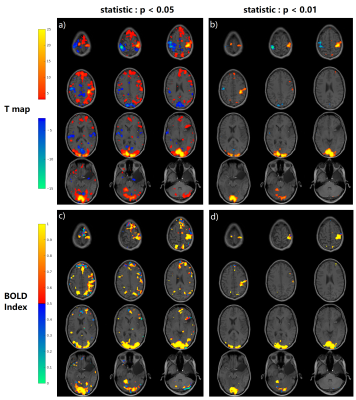 |
Multi-echo BOLD Index: Figuring out false positive and providing detailed activation patterns in task fMRI Video Permission Withheld
Wenchao Yang1, Burak Akin1, Xiang Gao1, Benedikt Poser2, and Jürgen Hennig1
1Department of Radiology, Medical Physics, Faculty of Medicine, Medical Center - University of Freiburg, Freiburg, Germany, 2Maastricht Brain Imaging Centre, Faculty of Psychology and Neuroscience, Maastricht University, Maastricht, Netherlands
We introduced a BOLD Index in this abstract. This index can figure out the false positive/non-BOLD voxels from standard fMRI t-test results. It can also provide detailed cortex active patterns. The BOLD Index high value is always marked on gray matter, while, the t-test high value is marked on the CSF or vein in cortex fissure or sulci. T-test answers the question of which voxel is active. The BOLD index tells whether the voxel's response is true BOLD or non-BOLD and how strong.
|
|||
2694.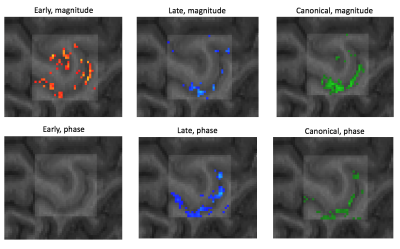 |
A setup for 3 T submillimeter layer-dependent fMRI weighted toward microvasculature
Lasse Knudsen1 and Torben Ellegaard Lund1
1Center of Integrative Neuroscience, Aarhus University, Århus N, Denmark
The field of layer-dependent fMRI is challenged by draining veins hampering the spatial specificity, and low SNR due to small voxel sizes. Here we present a setup for layer-dependent fMRI that aims to tackle these problems, while being feasible at highly available and clinically approved 3T systems. It relies on recently published post-processing techniques for thermal noise reduction and removal of response components weighted toward macrovasculature. Our initial results suggest sufficient sensitivity for detection of robust layer specific signals. Furthermore, statistical maps are largely free from superficial bias and previously reported double stripe features emerge, indicating strong weighting toward microvasculature.
|
|||
2695.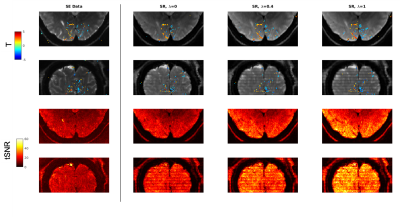 |
Evaluation of spin-echo generalized Slice Dithered Enhanced Resolution (gSLIDER) for high-resolution fMRI at 3T.
Alexander JS Beckett1,2, Salvatore Torrisi1,2, Kawin Setsompop3, David A Feinberg1,2, and An T Vu4,5
1Helen Wills Neuroscience Institute, University of California, Berkeley, CA, United States, 2Advanced MRI Technologies, Sebastopol, CA, United States, 3Radiological Sciences Laboratory, Stanford University, Stanford, CA, United States, 4Radiology, University of California, San Francisco, CA, United States, 5San Francisco Veteran Affairs Health Care System, San Francisco, CA, United States We demonstrate the use of generalized Slice Dithered Enhanced Resolution (gSLIDER) for high-resolution spin-echo (SE) fMRI. Activations were comparable to standard SE fMRI at varying levels of regularization, demonstrating the suitability of this method for high-resolution fMRI.
|
|||
2696.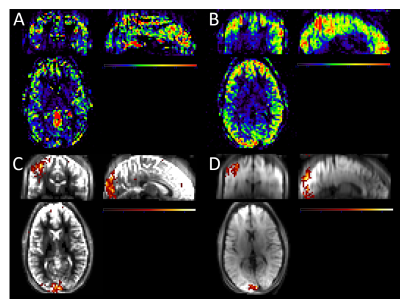 |
The influence of undersampling scheme and labeling approach on functional arterial spin labeling with single-shot 3D GRASE readout at 3T
Dimo Ivanov1, Josef Pfeuffer2, Anna Gardumi1, Kâmil Uludağ3, and Benedikt A Poser1
1Faculty of Psychology and Neuroscience, Maastricht University, Maastricht, Netherlands, 2Siemens Healthineers, Erlangen, Germany, 3Techna Institute & Koerner Scientist in MR Imaging, Joint Department of Medical Imaging and Krembil Brain Institute, Toronto, ON, Canada
Arterial spin labeling (ASL) fMRI is beneficial, but suffers from low temporal signal-to-noise ratio (tSNR). We compared GRAPPA- and CAIPI-accelerated optimized short-TR single-shot 3D GRASE PASL and PCASL approaches at 3T. The CAIPI acceleration approach results in equally good or better results than the GRAPPA technique. Despite having higher perfusion tSNR, PCASL did not lead to significantly higher activation z-scores than PASL, reflecting the influence of larger number of samples for the latter. In conclusion, the higher (perfusion) tSNR efficiency of PCASL does not always guarantee outperformance and the best ASL fMRI approach will depend on the specific experimental parameters.
|
|||
2697.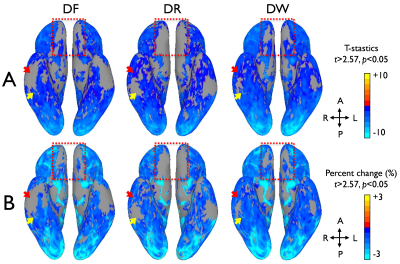 |
Improving task fMRI reliability at brain regions of high‐susceptibility using a multi-band PSF-mapping-based reverse-gradient approach
Myung-Ho In1, Daehun Kang1, Hang Joon Jo2, Uten Yarach3, Joshua D Trzasko1, Nolan K Meyer1,4, Bardwell Speltz J Lydia 1,4, John Huston III1, Matt A Bernstein1, and Yunhong Shu1
1Department of Radiology, Mayo Clinic, Rochester, MN, United States, 2Department of Physiology, College of Medicine, Hanyang University, Seoul, Korea, Republic of, 3Department of Radiologic Technology, Faculty of Associated Medical Sciences, Chiang Mai University, Chiang Mai, Thailand, 4Mayo Clinic Graduate School of Biomedical Sciences, Mayo Clinic, Rochester, MN, United States
Interleaved reverse-gradient fMRI (RG-fMRI) with a PSF mapping-based distortion correction scheme has the potential to minimize the loss of signal in regions of rapid susceptibility change. Recently, multi-band imaging was combined to improve the temporal resolution for RG-fMRI, and the initial feasibility was evaluated in human. In this work, breath-holding task-fMRI was performed with the proposed scheme to demonstrate the effectiveness in improving fMRI reliability for each individual and the entire group, especially in high susceptibility brain regions.
|
|||
2698.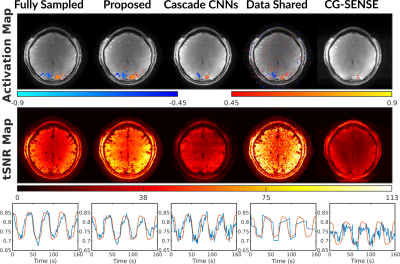 |
Recurrent U-Net Based Temporal Regularization for Dynamic Undersampled Reconstruction in OSSI fMRI
Shouchang Guo1 and Douglas C. Noll2
1Electrical Engineering and Computer Science, University of Michigan, Ann Arbor, MI, United States, 2Biomedical Engineering, University of Michigan, Ann Arbor, MI, United States
Using deep learning for undersampled reconstruction has shown advantages for structural MRI and dynamic MRI, but is not commonly used for fMRI. In this work, we propose a neural network based reconstruction with temporal regularization to exploit the temporal redundancy of oscillating steady-state fMRI images. With a factor of 6 undersampling, the proposed method outperforms other approaches such as cascade of convolutional neural networks with high-resolution and high-quality fMRI results.
|
|||
2699.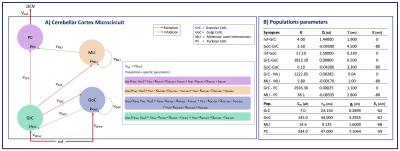 |
Biologically-driven cerebellar neural mass model for improving BOLD signal simulations
Roberta Maria Lorenzi1, Alice Geminiani1, Claudia A.M. Gandini Wheeler-Kingshott1,2,3, Fulvia Palesi1,3, Claudia Casellato1, and Egidio D'Angelo1,3
1Department of Brain and Behavioral Sciences, University of Pavia, Pavia, Italy, 2NMR Research Unit, Queen Square MS Centre, Department of Neuroinflammation, UCL Queen Square Institute of Neurology, Faculty of Brain Sciences, University College London (UCL), London, United Kingdom, 3Brain Connectivity Centre Research Department, IRCCS Mondino Foundation, Pavia, Italy
Whole-brain activity can be simulated as a collection of BOLD signals by solving mathematical models representing neuronal circuitry organization of different brain regions. The cerebellum strongly contributes to the whole-brain dynamics. We present the formalism for a mean-field model reproducing cerebellar physiological properties, which model-core is the transfer function transforming neurons spiking-patterns into time-continuous global activity. Combined with other models integrated in simulators, like DCM (Dynamic Causal Modeling) and TVB (The Virtual Brain), our cerebellar network will allow to investigate neuronal functions at the origin of macroscopic hemodynamic properties captured by BOLD.
|
|||
2700.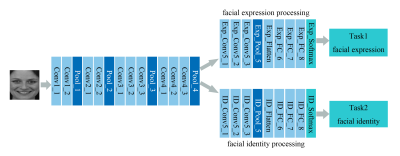 |
Multi-task deep neural network reveals distinct and hierarchical pathways for face perception in visual cortex
HUI ZHANG1,2, XUETONG DING1,2, and JIAQI ZHOU3
1Beijing Advanced Innovation Center for Big Data-Based Precision Medicine(BDBPM), Beihang University, Beijing 100083, China, Beihang University, Beijing, China, 2Key Laboratory of Molecular Imaging, Institute of Automation, Chinese Academy of Sciences, Beijing 100190, China, Beijing, China, 3Department of computer science, Beihang University, Beijing, China
We developed a multi-task deep neural network (DNN) model that can simultaneously classify facial expressions and identities. The model’s architecture and weights were optimized, and then used as an efficient tool to investigate the neural responses to facial expression and identity perception in an fMRI experiment. Our results revealed distinct visual pathways for facial expression and identity processing in the dorsal and ventral pathways in IT cortex, respectively. We also found hierarchical processing for facial expression and identity within the visual pathways.
|
|||
2701.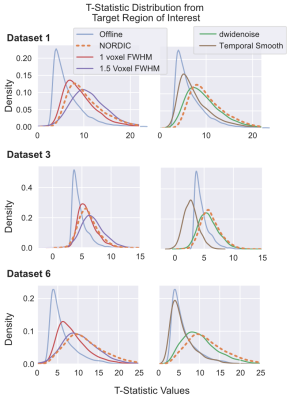 |
Evaluating data precision and signal gains in functional neuroimaging data after NOise reduction with DIstribution Corrected PCA (NORDIC)
Logan T. Dowdle1, Luca Vizioli2,3, Steen Moeller2, Cheryl Olman4, Geoffrey Ghose1,2,4, Essa Yacoub2, and Kamil Ugurbil1,2,5
1Neurosciences, Center for Magnetic Resonance Research, Minneapolis, MN, United States, 2Radiology, Center for Magnetic Resonance Research, Minneapolis, MN, United States, 3Neurosurgery, University of Minnesota, Minneapolis, MN, United States, 4Psychology, University of Minnesota, Minneapolis, MN, United States, 5Medicine, Center for Magnetic Resonance Research, Minneapolis, MN, United States
Functional neuroimaging with gradient echo BOLD has moved to higher and higher spatial and temporal resolutions, which leads to with higher levels of unstructured thermal noise. Here we evaluate the application of the NORDIC method, which suppresses thermal noise, on 7 datasets. We find that NORDIC improve t-values, while not significantly altering fMRI signal characteristics. In addition, a single run of NORDIC data is able to predict held out, original data equally as well as 2 to 3 runs of the original data. NORDIC is a promising new method for dramatically increasing the signal to noise ratio of BOLD imaging.
|
|||
2702.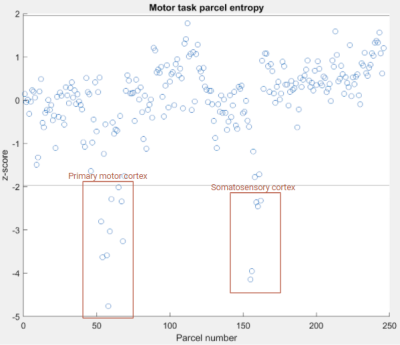 |
Multiscale sample entropy analysis of resting-state and task fMRI
Mary Katherine Gale1, Maysam Nezafati1, and Shella Keilholz1
1Biomedical Engineering, Georgia Institute of Technology, Atlanta, GA, United States
Sample entropy can be used to assess BOLD signal complexity and predictability in resting-state and task fMRI. Task-relevant brain regions tend to display significantly lower entropy than less relevant regions. This trend appears most distinctly in tasks that involve cortical structures, such as a motor task involving the motor cortex, as opposed to tasks that involve subcortical nuclei, such as an emotion task involving the amygdala. Additionally, there is a strong negative correlation between BOLD signal amplitude and entropy that appears only in task-based fMRI, indicating that BOLD signal, as recruited by a task, becomes more predictable as amplitude increases.
|
|||
2703.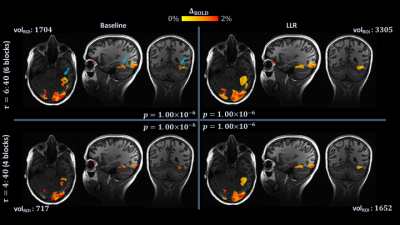 |
Locally low-rank denoising preserves statistical confidence in task-based functional activation under scan duration reduction
Nolan Meyer1, Norbert G Campeau2, David F Black2, Kirk M Welker2, Erin Gray2, Daehun Kang2, MyungHo In2, John Huston2, Yunhong Shu2, Matt A Bernstein2, and Joshua D Trzasko2
1Mayo Clinic Graduate School of Biomedical Sciences, Rochester, MN, United States, 2Radiology, Mayo Clinic, Rochester, MN, United States
Functional MRI activation maps derived from locally low-rank (LLR) denoising of complex-valued time series echo planar imaging (EPI) data were compared to those obtained from conventional non-denoised data for a six-block verbal task-based fMRI exam obtained in five healthy subjects, as data were retrospectively truncated block-by-block. The LLR-denoised fMRI activation maps exhibited superior performance as timeframes were removed in sets of blocks, with acceptable statistical confidence overall in localizing verbal activation following retrospective truncation of scan data. LLR denoising significantly increases temporal signal to noise ratio of timecourse data, a performance advantage which remains stable as timeframes are removed.
|
|||
2704.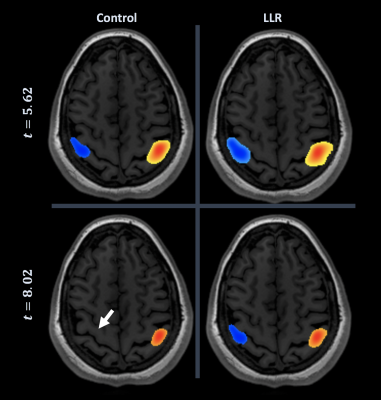 |
Initial clinical evaluation of locally low-rank denoising on motor areas for task-based presurgical functional MRI
Nolan Meyer1, Norbert G Campeau2, David F Black2, Kirk M Welker2, Erin Gray2, Daehun Kang2, MyungHo In2, John Huston2, Yunhong Shu2, Matt A Bernstein2, and Joshua D Trzasko2
1Mayo Clinic Graduate School of Biomedical Sciences, Rochester, MN, United States, 2Radiology, Mayo Clinic, Rochester, MN, United States
In a preliminary evaluation of task-based motor fMRI data of five healthy subjects, locally low-rank (LLR) denoising is evaluated for clinical performance. Complex-valued timecourse echo planar imaging (EPI) data from finger-tapping exams were LLR-denoised and equivalently processed alongside control images. Statistical thresholds of LLR-denoised and control data were assessed by four board-certified neuroradiologists for four specific clinically relevant clusters and overall. LLR denoising predominantly yields increased thresholds for four specific cluster regions and aggregate maps in a preliminary analysis.
|
|||
2705.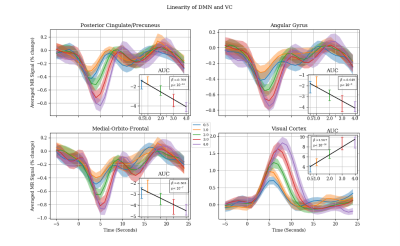 |
Linearity of the task-evoked negative BOLD response from the Default mode network regions
Amirreza Sedaghat1, Farnia Feiz2, Sreyansh Biswall2, Sindy Ozoria2, and Qolamreza R Razlighi2
1Biomedical Engineering, Columbia University, New York, NY, United States, 2Radiology, Weill Cornell Medicine, New York, NY, United States
There is emerging evidence that demonstrate spatial and temporal characteristics of the positive BOLD responses, however, the accompanying negative BOLD responses (NBR) are still under investigation. This is surprising since studies investigating NBR started as early as the introduction of the BOLD-fMRI. While there are limited number of studies that have utilized NBR in the normal aging and Alzheimer’s disease, we feel the NBR has not been used to its full capacity in the field. Recently, within the past two years, the number of publications on NBR has increased, making the timing of this research appropriate.
|
|||
2706.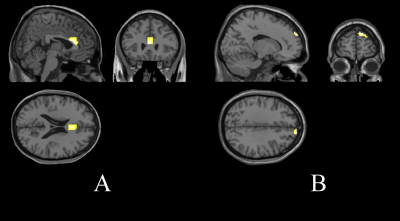 |
The treatment effects of quitting smoking by varenicline — a fMRI study
Peng Peng1, Chun-lin Li2, Bin Jing2, Qing-lei Shi3, and Tao Jiang1
1Radiology, Beijing Chao-yang Hospital, Beijing, China, 2School of biomedical engineering, Capital medical university, Beijing, China, 3HC NEA DI MR Siemens Healthcare Ltd, Beijing, China
This study investigated the activation changes of brain regions to smoking related visual stimulation in smokers before and after cessation treatment using a fMRI. The results demonstrated that treated smokers will have improved functions of brain regions related to addiction control after using varenicline.
|
|||
2707.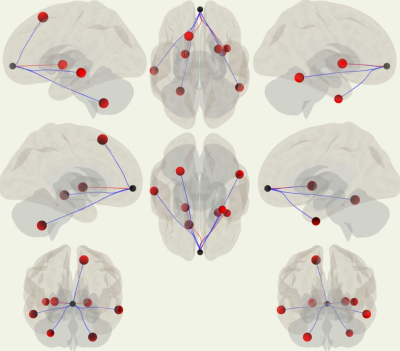 |
Individualized cue-response fMRI study in gaming disorder
Pavel Tikhonov1, Alexander Efimtcev2, Dmitriy Iskhakov2, and Mikhail Zubkov1
1Department of Physics and Engineering, ITMO University, Saint-Petersberg, Russian Federation, 2Department of Radiology, Federal Almazov North‐West Medical Research Center, Saint-Petersberg, Russian Federation
Task-related fMRI studies are providing increasing amount of information on the neurobiological aspects of the Gaming Disorder. This study aims to further explore the functional connectivities present in the gaming disorder subject brain via task-based fMRI study using individualized visual stimuli. 22 participants undergo fMRI scanning with gaming-related and neutral visual stimuli. Data analysis shows altered medial prefrontal cortex connectivity resembling that in cases of substance addiction.
|
|||
2708.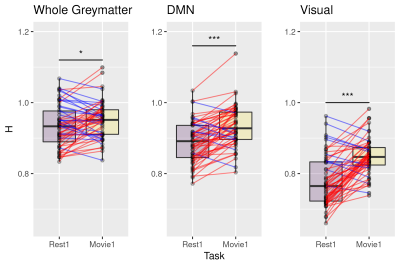 |
Fractal-Based Analysis of Movie Watching vs. Eyes-Open Resting State Reveals Widespread Differences in fMRI Signal Complexity
Olivia Lauren Campbell1, Tamara Vanderwal1, and Alexander Mark Weber1
1University of British Columbia, Vancouver, BC, Canada
Previous studies of functional magnetic resonance imaging (fMRI) have found that the ‘resting-state’ is more fractal than task performance. Investigating the behaviour of brain signals under naturalistic conditions, we performed fractal analysis of 7T fMRI data (n=55) under movie-watching (Movie; 10mins) and eyes-open with fixation-cross (Rest; 10mins) conditions. Compared to Rest, Movie, the more natural stimulus, showed greater fractal scaling in all three regions analyzed: whole-brain greymatter (adj_p.=0.014, Cohen’s_D=0.34), default mode network (adj_p.=2.55x10-8, Cohen’s_D=0.90), and visual network (adj_p.=6.44x10-10, Cohen’s_D=1.05), reflecting the endogenous scale-invariant state of the brain.
|
|||
2709.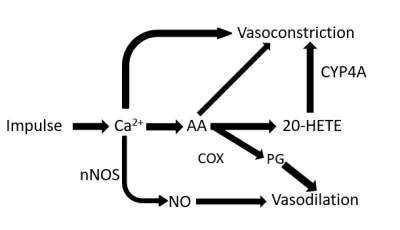 |
Effect of acetylsalicylic acid on BOLD signal in human brain during video stimulation. Functional MRI study.
Maxim Ublinskiy1,2, Andrei Manzhurtsev1,2,3, Alexei Yakovlev1,2,3, Natalia Semenova1,2,3, and Tolibjon Akhadov1,3
1Clinical and Research Institute of Emergency Pediatric Surgery and Trauma, Moscow, Russian Federation, 2Insitute of Biochemical Physics, Russian Academy of Sciences, Moscow, Russian Federation, 3Moscow State University, Moscow, Russian Federation
Changes in intensity of BOLD response to stimulation can serve as a measure of participation of the above processes in the mechanisms of action of aspirin on vascular system. To test this hypothesis, we studied the effect of aspirin on the intensity of the BOLD signal in human brain during visual stimulation.
|
|||
2710.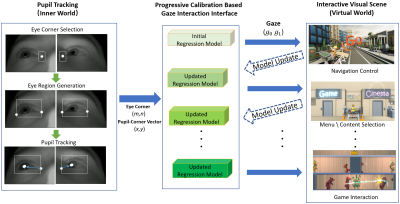 |
A progressive calibration gaze interaction interface to enable to naturalistic fMRI experiments
Kun Qian1, Tomoki Arichi1, A David Edwards1, and Jo V Hajnal1
1King's College London, London, United Kingdom
fMRI studies of higher level cognitive processing stretch current stimulus presentation paradigms. Adding the capability for subjects to intuitively interact with a virtual world has huge potential for advancing such studies. Gaze tracking can provide rich information about attention, but maintaining accurate gaze estimation is compromised by head movement and most systems do not allow visual interaction. We describe a gaze interaction interface that exploits each new fixation to achieve robust and accurate perfromance even during head movement. This opens opportunities for naturalistic, flexible and complex fMRI experiments, particularly for challenging populations like children and those with cognitive difficulties.
|
|||
2711.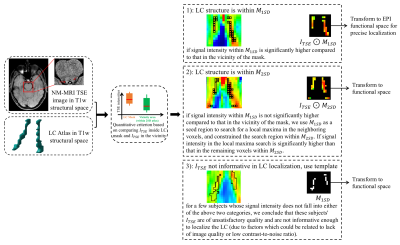 |
An Automatic and Subject-specific Method for Locus Coeruleus Localization and BOLD Activity Extraction
Hengda He1, Linbi Hong1, and Paul Sajda1,2,3,4
1Department of Biomedical Engineering, Columbia University, New York, NY, United States, 2Department of Electrical Engineering, Columbia University, New York, NY, United States, 3Department of Radiology, Columbia University, New York, NY, United States, 4Data Science Institute, Columbia University, New York, NY, United States
The locus coeruleus (LC) is a small nucleus in the brainstem whose function is integral to regulating cognitive arousal. Despite the LC’s importance in cognitive processing, localizing it in functional space is challenging. Here, we propose a method that uses both an atlas and subjects’ neuromelanin-sensitive MRI images to estimate LC BOLD activity. We show that the LC BOLD extracted with our method is more strongly correlated with trial-to-trial variability in baseline pupil diameter than comparable approaches, an important metric since non-luminance changes in pupil diameter have been shown to covary with LC electrophysiological recordings in non-human primates.
|
|||
2712.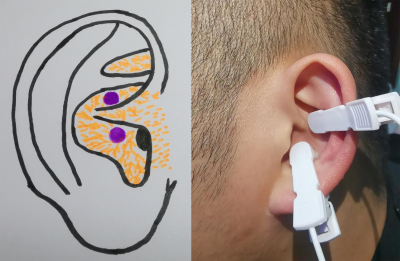 |
The neuro-brain functional mechanisms that cause different efficacy of transcutaneous auricular vagus nerve stimulation on primary insomnia
Xiao Wu1, Yue Zhang2, and Ji-lei Zhang3
1Department of chinese medicine, Sichuan Provincial People's Hospital, University of Electronic Science and Technology of China, Chengdu, China, 2The Second Affiliated Hospital of Guangzhou University of Chinese Medicine, Guangzhou, China, 3Philips Healthcare, Shanghai, China
Recently, some studies have reported the efficacy of transcutaneous auricular vagus nerve stimulation (taVNS) on primary insomnia. However, its effective rate fluctuated greatly. Therefore, our study aimed at studying the reasons that caused the different efficacy of taVNS.
|
The International Society for Magnetic Resonance in Medicine is accredited by the Accreditation Council for Continuing Medical Education to provide continuing medical education for physicians.